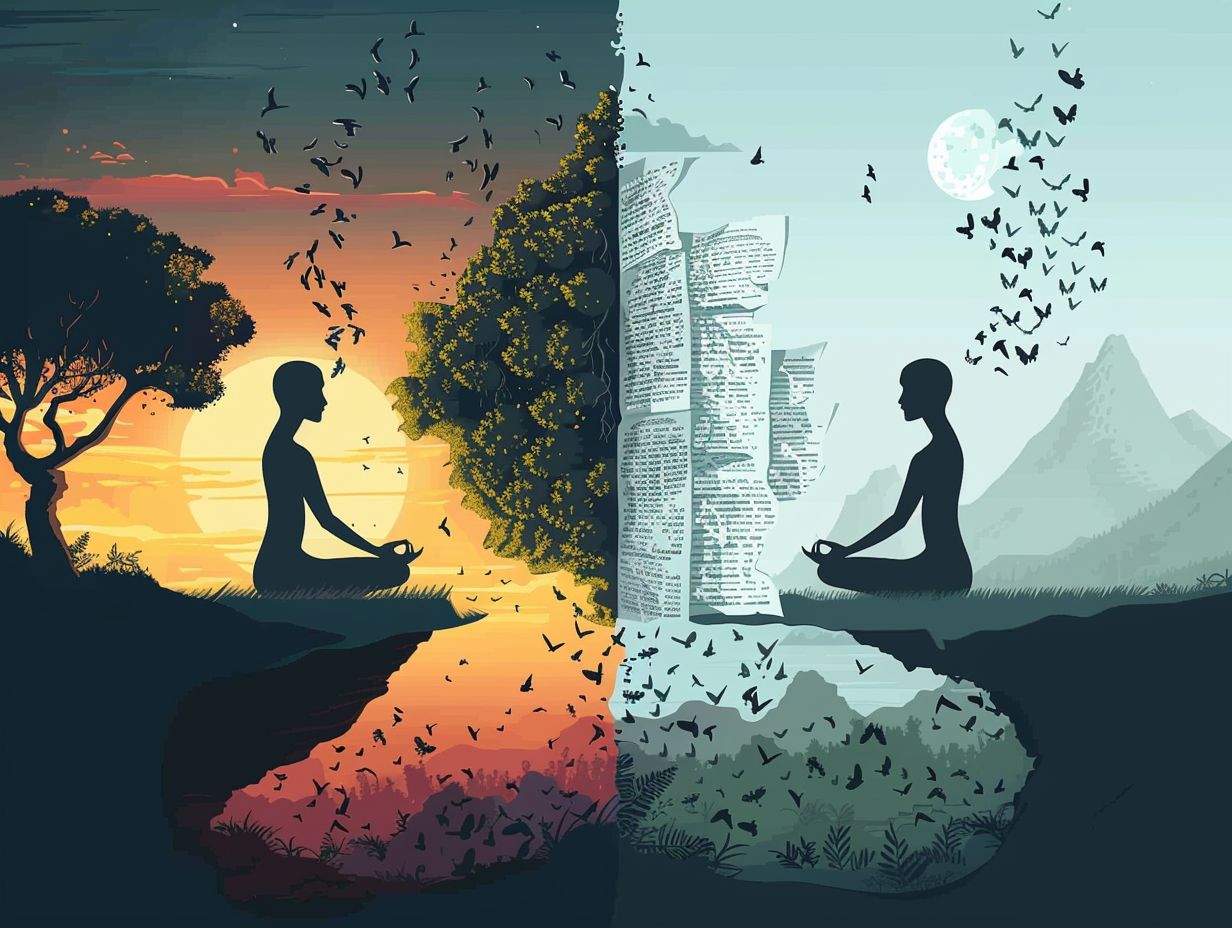Comparison of Yoga and Samkhya by Max Muller
Yoga and Samkhya are two ancient philosophies that have profoundly influenced spiritual and wellness practices in the contemporary world. While yoga is widely revered for its physical postures and the mental clarity it cultivates, Samkhya provides a rich philosophical framework that delves into the essence of existence and consciousness.
This exploration examines the history, principles, and practices of both traditions, illuminating their distinct similarities and differences. Readers will uncover the unique benefits each tradition offers for physical and mental well-being, as well as strategies for integrating these timeless teachings into daily life.
What is Yoga?

Yoga stands as an ancient Indian philosophy, seamlessly intertwining physical postures, meditation, and ethical principles to elevate overall well-being and promote personal growth.
Anchored in revered texts such as the Yoga Sutras and the Vedic scriptures, it emerges as a holistic spiritual practice designed to facilitate self-realization and inner tranquility.
Through diverse yoga practices, practitioners delve into their consciousness and nurture mindfulness, fostering a deep connection between the mind and body while striving for spiritual enlightenment and liberation (moksha).
History of Yoga
The history of Yoga spans thousands of years, originating from the profound depths of ancient Indian philosophy and cultural practices that sought to unravel the mysteries of consciousness and its intricate relationship with both the self and the universe.
This rich tapestry of development is woven with influential texts such as the Vedas and Upanishads, which established the foundational principles for various schools of thought. Over time, pivotal figures like Patanjali emerged, formalizing the practice through his Yoga Sutras, which intricately connected Yoga with meditative techniques and ethical principles that continue to resonate in contemporary practice.
As Yoga evolved, it became intertwined with Buddhist and Jain traditions, further enriching its philosophical and practical dimensions. In the modern era, Yoga has transcended geographical and cultural boundaries, adapting to diverse contexts ranging from the vigorous Hatha Yoga that gained popularity in the West to the more subtle forms cultivated in India reflecting a harmonious blend of ancient wisdom and contemporary ideals.
Types of Yoga
There exists a rich diversity of Yoga styles, each presenting unique methodologies aimed at fostering various dimensions of personal growth, mindfulness, and spiritual discipline.
Hatha Yoga often stands as the cornerstone of these practices, centering on postures and breath control, thus serving as an excellent entry point for novices eager to cultivate strength and flexibility. Conversely, Vinyasa flows effortlessly from one pose to the next, highlighting the intrinsic connection between breath and movement, which has the dual effect of invigorating the body while soothing the mind.
Kundalini Yoga distinguishes itself by its intent to awaken the dormant spiritual energy within practitioners through a series of specific sequences, chants, and meditations, ultimately nurturing a profound sense of self-awareness. Meanwhile, Ashtanga presents a dynamic and physically demanding approach that intertwines a fixed series of postures with breath, appealing particularly to those in pursuit of a rigorous workout that enhances strength, flexibility, and stamina.
Each of these styles not only promotes physical well-being but also serves as a distinct path toward emotional equilibrium and spiritual advancement.
What is Samkhya?
Samkhya stands as one of the six esteemed orthodox schools of Indian philosophy, distinguished by its dualist framework that clearly delineates the distinction between consciousness (purusha) and matter (prakriti). It embodies a profound exploration into the essence of existence and the nature of the self.
History of Samkhya
The history of Samkhya traces back to the early centuries of Indian civilization, with its roots intricately woven into ancient texts that articulate its philosophical foundations and principles. This venerable school of thought emerged in a milieu rich with spiritual inquiry and was later systematized in the influential text known as the Samkhya Sutra, attributed to the sage Kapila.
Over the centuries, Samkhya has evolved, mirroring the social dynamics and intellectual currents of its time. The dialogue between Samkhya and other philosophical traditions, such as Yoga and Buddhism, has further enriched its framework, introducing a plethora of new ideas and interpretations. Key figures, including the later commentator Ishvara Krishna, played crucial roles in codifying its tenets, ensuring that its teachings remained resonant across generations.
Therefore, the evolution of Samkhya philosophy stands not only as a testament to its own resilience but also as a reflection of its engagement with the broader philosophical discourse within Indian civilization.
Key Principles of Samkhya

The key principles of Samkhya are rooted in its dualistic philosophy, which emphasizes a fundamental separation between consciousness (purusha) and the material world (prakriti), together encompassing the entirety of human experience. This distinction serves as the foundation for a deeper understanding of reality and the self.
In the Samkhya framework, purusha embodies the eternal and unchanging aspect of being, while prakriti signifies the dynamic realm of phenomena, including thoughts, emotions, and physical sensations. Recognizing this separation is essential, as it nurtures self-awareness and fosters the pursuit of knowledge an endeavor highly esteemed within this philosophical system.
The journey toward liberation entails discerning the true essence of purusha by transcending attachments to prakriti. This transformative process encourages personal development, urging individuals to cultivate detachment and mindfulness. Ultimately, this path leads to spiritual awakening and a greater clarity in navigating the complexities of life.
Comparison between Yoga and Samkhya
The exploration of Yoga and Samkhya unveils a profound interplay of philosophical concepts, wherein both systems are rooted in shared foundational beliefs, yet they diverge significantly in their practices and objectives.
This nuanced relationship provides an enriching foundation for philosophical discourse, inviting deeper contemplation and discussion.
Similarities between Yoga and Samkhya
Both Yoga and Samkhya reveal significant parallels, particularly in their dualistic perspectives and their emphasis on consciousness as the ultimate reality in the quest for spiritual enlightenment.
These philosophies intricately explore the relationship between the mind and the material world, suggesting that authentic knowledge emerges from the discernment of the eternal self apart from fleeting phenomena. They contend that the path to enlightenment is contingent upon disciplined practices that nurture self-awareness, mindfulness, and inner peace.
By advocating for meditative techniques and ethical living, these traditions underscore the transformative potential inherent in spiritual practices. This common foundation not only fosters personal growth but also cultivates a comprehensive understanding of existence, promoting a harmonious balance between one s internal experiences and the external world.
Differences between Yoga and Samkhya
While Yoga and Samkhya share a philosophical foundation, they diverge significantly in their methodologies and approaches to attaining liberation. Yoga embraces practical disciplines and ethical principles that extend well beyond Samkhya’s theoretical framework.
In essence, Yoga underscores a holistic process that encompasses physical postures, breath control, and meditation, intricately weaving these elements into a cohesive practice centered on self-realization. Conversely, Samkhya presents a dualistic framework that prioritizes the intellectual understanding of reality, advocating a more cerebral pathway to spiritual insight.
This fundamental distinction gives rise to varied experiences; the yogic path promotes direct engagement with both body and mind, fostering discipline and ethical living, while the Samkhya approach encourages introspection and intellectual discernment.
By illuminating these differences, practitioners can gain a deeper appreciation for how each system offers distinct yet complementary tools for personal transformation and spiritual evolution.
How are Yoga and Samkhya Practiced?
Yoga and Samkhya, while differing in their methodologies, both espouse a variety of practices designed to foster mindfulness, deepen self-awareness, and facilitate spiritual development.
Yoga Practices

Yoga practices encompass a rich tapestry of techniques, meticulously crafted to cultivate mindfulness, enhance physical well-being, and facilitate personal transformation through various spiritual disciplines.
Among these techniques, the practice of asanas commonly known as postures not only enhances flexibility and strength but also serves to awaken the body’s energy channels, thereby preparing it for deeper introspection. Pranayama, which emphasizes breath control, is crucial for harmonizing the mind and body, fostering clarity, and soothing the nervous system.
Meditation serves as the connective thread among these practices, allowing individuals to access a profound sense of inner peace and heightened self-awareness. Through consistent engagement in these holistic approaches, practitioners embark on a transformative journey that ultimately leads to self-realization and equips them to navigate life’s challenges with grace and poise.
Samkhya Practices
Samkhya practices center on philosophical inquiry and self-examination, fostering a profound comprehension of reality and the self through rigorous reflection and analytical thinking.
By regularly engaging in these practices, individuals can cultivate an enhanced awareness of their thoughts, emotions, and behaviors. This intentional engagement aids in unraveling life’s complexities, enabling one to differentiate between fleeting impulses and enduring truths.
The philosophical insights provided by Samkhya not only promote cognitive growth but also pave the way for spiritual enlightenment. For many, this transformative journey cultivates greater wisdom, equipping them to navigate life’s challenges with poise and clarity.
Such self-awareness nurtures a profound appreciation for existence, fostering a harmonious relationship with both the self and the broader world.
Benefits of Yoga and Samkhya
The advantages of Yoga and Samkhya span a multitude of dimensions, encompassing physical health, mental well-being, and significant personal development.
These practices are vital components of holistic health and contribute meaningfully to spiritual evolution.
Physical Benefits
The physical benefits of yoga are extensive, promoting enhanced flexibility, strength, and overall health, while serving as an essential component of holistic well-being.
Through regular engagement in yoga practice, individuals can witness a remarkable increase in their flexibility, allowing their muscles and joints to move more freely. This increased mobility is crucial for preventing injuries and fostering overall movement.
Furthermore, yoga plays a significant role in building core strength, which not only enhances physical performance across various activities but also contributes to improved posture and alignment. Such improvements are vital in alleviating chronic pain and discomfort associated with poor posture.
Additionally, yoga’s focus on controlled breathing enhances cardiovascular health by promoting better circulation and reducing stress levels. This leads to an overall improved sense of vitality and well-being.
Mental Benefits
The mental benefits of Yoga and Samkhya are truly profound, often leading practitioners to enhanced mindfulness, reduced stress, and a greater sense of inner peace through meditation and reflective practices.
These ancient disciplines encourage individuals to cultivate self-awareness and emotional regulation, which in turn fosters resilience against the pressures of everyday life. Participants frequently report a notable decrease in anxiety and depressive symptoms, as the techniques employed help release pent-up tension and promote a more positive outlook.
Engagement in these practices can also stimulate cognitive development, resulting in sharper focus and improved memory. As practitioners delve deeper into these disciplines, they often undergo significant personal growth, uncovering new aspects of themselves and forging a clearer path toward self-realization, thereby enhancing their overall psychological well-being.
Frequently Asked Questions

What is the main difference between Yoga and Samkhya?
The main difference between Yoga and Samkhya is that Yoga focuses on practicing physical postures, breath control, and meditation in order to achieve spiritual liberation, while Samkhya focuses on understanding the nature of the self and the universe through rational analysis.
Which philosophy, Yoga or Samkhya, is considered the foundation of Hinduism?
Both Yoga and Samkhya are considered foundational philosophies of Hinduism, with Yoga being the more practical and experiential aspect and Samkhya providing the theoretical framework.
How do the goals of Yoga and Samkhya differ?
The ultimate goal of Yoga is to achieve spiritual liberation or enlightenment, while the goal of Samkhya is to attain knowledge and understanding of the true nature of the self and the universe.
Are there any similarities between Yoga and Samkhya?
Yes, there are several similarities between Yoga and Samkhya, such as the belief in the existence of a supreme reality, the concept of self-realization or self-awareness, and the importance of practicing detachment and non-attachment.
Is one philosophy, Yoga or Samkhya, considered more practical than the other?
Yoga is often seen as the more practical philosophy, as it offers tangible techniques and practices that can be applied in daily life to achieve spiritual growth. However, Samkhya is also considered practical in its approach to understanding the nature of reality and the self.
Can one practice both Yoga and Samkhya simultaneously?
Yes, it is possible to practice both Yoga and Samkhya simultaneously, as they complement each other and offer different aspects of spiritual growth. Many practitioners incorporate elements from both philosophies in their spiritual practice.
